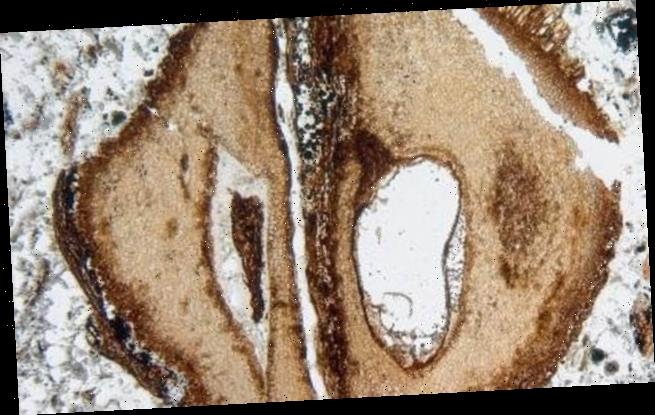World’s oldest piece of mahogany is found in Canada and dates back almost 80MILLION years to when the dinosaurs roamed the planet
- Chunk of mahogany was found in a piece of rock found near Vancouver Island
- It was dated to between 72 and 79 million years old – the end of the Cretaceous
- Previous evidence indicated mahogany only emerged 20 million years later
A piece of mahogany has been unearthed just off the coast of Vancouver Island in Canada and is believed to be the oldest sample of the hardwood ever found.
The fossilised chunk of timber dates back to the end of the Cretaceous period roughly 80 million years ago.
Previously, it was through mahogany only existed as far back as 60 million years ago, after the demise of the dinosaurs.
Scroll down for video
The specimen (pictured) has been named Manchestercarpa vancouverensis. Evidence of a fleshy layer of fruit and seeds can still be seen in the fossil. The fossil is closely related to the mahogany trees seen today
WHAT IS MAHOGANY?
Mahogany is a type of timber made from tropical trees.
It is a hard reddish-brown timber used for making furniture.
It has been in existence for around 80million years and is used in the fossil record to reveal locations of past rainforests.
Mahogany trees can reach 200 feet tall.
They grow bright purple-yellow flowers and edible, woody fruit that locals eat.
The United States is the world’s top importer of the tropical timber from South America’s producers.
Unfortunately, mahogany is often harvested illegally. The trees are among those most threatened by deforestation in the Amazon.
Brazil has banned mahogany logging, except for companies who guarantee to replant.
It is their most expensive wood, and the smugglers’ main markets include the United States, Britain and Japan.
The specimen has been named Manchestercarpa vancouverensis.
The species name vancouverensis is a nod to its location while the genus name Manchestercarpa is to honour a prominent scientist, Steve Manchester at the University of Florida Museum of Natural History.
Evidence of a fleshy layer of fruit and seeds can still be seen in the fossil.
Dr Brian Atkinson, a paleobotanist from the University of Kansas, stumbled upon the fossil by chance and analysis revealed it to be between 72 and 79 million years old.
The rock containing the fossil was found by a local fossil hunter called Graham Beard, director of the Qualicum Beach Museum of Natural History.
Mr Beard’s rock was being investigated by Dr Atkinson for another fossil trapped within.
But as analysis progressed, the stone revealed a treasure trove of prehistoric fossils, including the mahogany.
Dr Atkinson analysed the structure of the mahogany and traced its genetic history to figure out its relationship to other species in the family.
This showed the fossil, which he admits was found by accident, is closely related to the mahogany trees seen today.
Mahogany plays a key role in the fossil record, as its existence and durability indicates the locations of now-extinct tropical rainforests.
Dr Atkinson explained: ‘For understanding when many of the different branches of the tree of life evolved, we are primarily dependent on the fossil record.
‘In this case, Meliaceae, the mahogany family, is an ecologically and economically important group of trees.
‘A lot of researchers have used this group as a study system to better understand the evolution of tropical rainforests.’
Mahogany had only been found dating back to the Paleocene around 60 million years ago but a study published today in the journal the American Journal of Botany found it was already well-established.
This study puts the origin of mahogany around the time where ecosystems were modernising and diversification into modern plant groups.
Today, mahogany is a sought after material and highly valued for its appearance and properties.
Dr Atkinson said: ‘You might own something made from mahogany like furniture, panelling or a musical instrument.’
Source: Read Full Article

